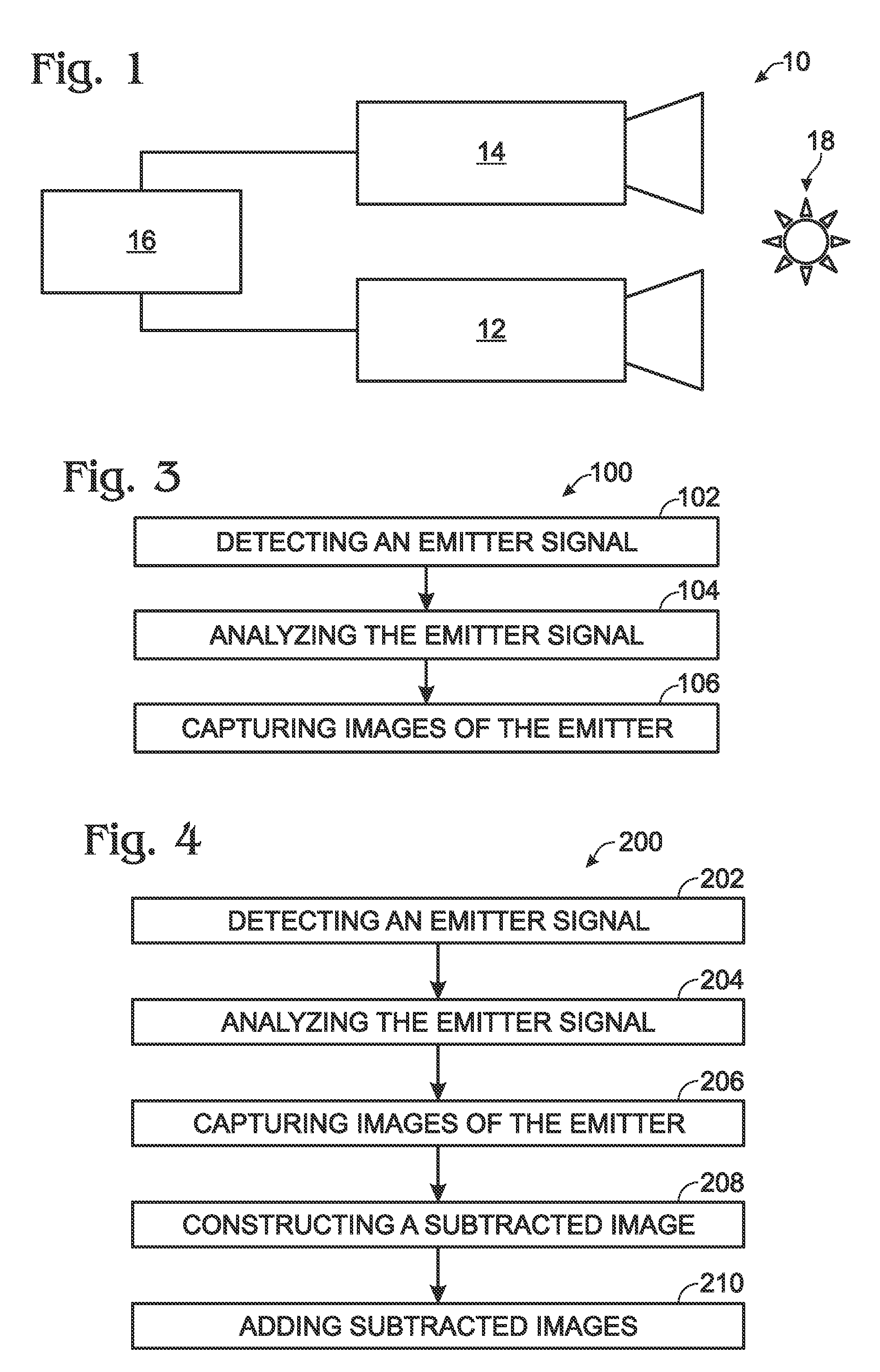Emitter tracking system
a technology of emitter tracking and tracking system, which is applied in the direction of image enhancement, direction controller, instruments, etc., can solve the problems of a number of shortcomings of existing beacon tracking systems, as well as those relying on them, and achieve the effect of increasing the signal-to-noise ratio of captured images
- Summary
- Abstract
- Description
- Claims
- Application Information
AI Technical Summary
Benefits of technology
Problems solved by technology
Method used
Image
Examples
example 1
[0032]This example relates to and further describes emitter tracking incorporating image subtraction, according to aspects of the present teachings. As described previously, once the presence and characteristic signal of an emitter has been detected, a processor may electronically subtract an emitter-off image from an emitter-on image, to eliminate background image noise and to improve the signal-to-noise ratio of the resultant subtracted image. The simplest way to accomplish this is for the imaging module to capture a single one-half period of the emitter signal for each image, corresponding to capturing one image with the emitter on, and one with the emitter off. Subtracting the emitter-off image from the emitter-on image results in an image of the emitter with relatively little background noise.
[0033]Alternatively, the system could be configured to capture and integrate multiple emitter-on and emitter-off images. For example, the imaging module could capture and integrate a compo...
example 2
[0034]This example relates to and further describes emitter tracking incorporating coded emitters, according to aspects of the present teachings. As described previously, an emitter signal may be coded to contain information about the signal emitter and / or to facilitate positively identifying the signature of a particular emitter. When an emitter tracking system seeks to track a coded emitter, the system may perform several steps in conjunction with, or prior to, capturing image data for display or tracking purposes. First, an emitter tracking system according to the present teachings may perform the preliminary step of extracting the emitter “pulse rate” or “clock” from the received emitter signal. Because this signal may, for example, include missing pulses and / or have an irregular frequency, characterizing the received signal with a processor may be necessary or desirable.
[0035]Once an incoming emitter signal has been received and characterized with a “pulse rate” or other defini...
example 3
[0036]This example relates to and further describes exemplary methods of tracking an emitter, according to aspects of the present teachings.
[0037]FIG. 3 is a flowchart depicting a first exemplary method, generally indicated at 100, of tracking an emitter according to aspects of the present teachings. Method 100 generally includes a step 102 of detecting an emitter signal, a step 104 of analyzing the signal to determine if the signal includes a signature corresponding to a particular emitter, and a step 106 of capturing images of the emitter. Generally, step 106 will be performed only if the detected emitter signal includes the desired signature, so that the power and other resources associated with capturing images need not be expended unless a desired emitter, which may be one of a predefined set, has been positively identified.
[0038]Detecting an emitter signal may be performed with a signal detection module, analyzing the detected signal may be performed with a processor, and capt...
PUM
 Login to View More
Login to View More Abstract
Description
Claims
Application Information
 Login to View More
Login to View More - R&D
- Intellectual Property
- Life Sciences
- Materials
- Tech Scout
- Unparalleled Data Quality
- Higher Quality Content
- 60% Fewer Hallucinations
Browse by: Latest US Patents, China's latest patents, Technical Efficacy Thesaurus, Application Domain, Technology Topic, Popular Technical Reports.
© 2025 PatSnap. All rights reserved.Legal|Privacy policy|Modern Slavery Act Transparency Statement|Sitemap|About US| Contact US: help@patsnap.com



